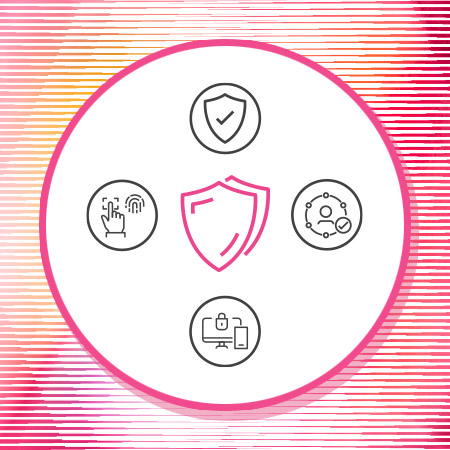Goals of IT Security
Simply put, IT security aims to ensure that computer systems are able to do their jobs. This largely boils down into protecting the “CIA triad”, which includes:
- Confidentiality: Protecting the privacy of data
- Integrity: Ensuring that data has not been modified
- Availability: Providing continual access to data and systems
Types of IT Security
IT security deals with all aspects of protecting IT assets against cyber threats. The modern business’s IT assets are spread across multiple different platforms, meaning that IT security must secure a wide range of different platforms from cybersecurity threats.
IT security includes:
- Identity Security: Identity security includes methods and processes to identify, verify and authorize machines, devices, users, groups, applications, and functions. This is essential to identity and access management (IAM).
- Network Security: Network security involves securing on-prem networks, wide area networks (WAN), and the Internet. Network segmentation, secure transport, secure access and content inspection to prevent threats are some methods used for securing networks.
- Cloud Security: As organizations increasingly adopt cloud technologies, they need cloud-specific security solutions. Common aspects of cloud security include solutions for IaaS security (covering infrastructure and workloads), PaaS security (securing applications and containers), and SaaS security (protecting office suites and email).
- Endpoint Security: As employees increasingly work from home, endpoint security is more important than ever. This includes device compliance and threat prevention for both traditional endpoints and mobile devices and securing Internet of Things (IoT) devices with device discovery, segmentation, and threat prevention.
- Application and API Security: Applications and application programming interfaces (APIs) are a major part of an organization’s attack surface and should be secured via code review, analysis and runtime analytics. In the modern organization, security is no longer bolted on or added as an overlay on top of Infrastructure as Code but is included in the CI/CD pipelines as part of Shift Left Security and DevSecOps initiatives.
- Management: Deploying an array of security solutions means that organizations need to manage them as well. This includes device configuration, monitoring, optimization, automation, and orchestration.
- Visibility And Incident Response: The goal of IT security is to protect the organization against cyber threats. To do so, organizations need to maintain visibility into their network, ingest threat intelligence, and engage in forensics, threat hunting, and threat mitigation as needed.
IT Security Threats
IT assets are a vital part of how organizations do business and a valuable target for cybercriminals. A number of threats to IT security exist, including:
- Vulnerability Exploitation: IT assets commonly run software that contains potentially exploitable vulnerabilities. Cybercriminals can take advantage of this by attacking these systems directly over the network or sending malicious files to exploit the vulnerabilities.
- Account Takeover: Cybercriminals can steal account credentials via phishing and other social engineering attacks. With these credentials, attackers can take over user accounts to steal sensitive data or use them in their attacks.
- Financially-Motivated Attacks: Cybercrime is a business with many opportunities to make money. These include ransomware, data exfiltration, and Denial of Service (DoS) attacks for financial extortion.
- Advanced Persistent Threats (APTs): APTs are sophisticated threat actors financed by nation-states or organized crime. These groups can launch very sophisticated attacks, such as exploitation of supply chain vulnerabilities.
- Poor Security Practices: Lax security configurations and access controls are a common problem in both on-prem and cloud-based environments. Examples include the use of default and weak credentials exploitable via brute force attacks.
IT Security vs Cybersecurity
IT security and cybersecurity are closely related. Both address the security of an organization’s IT assets and the data that they contain, and this includes protecting these assets against digital threats. IT may also include measures to secure IT from physical threats.
The main difference between IT security and cybersecurity is that cybersecurity goes beyond IT security. While cybersecurity encompasses IT security, it also includes other areas, such as protecting the sensitive and personal data of individuals or consumers and the telecommunications and critical infrastructure sectors.
IT Security vs OT Security
Operational Technology (OT) systems are used in environments such as critical infrastructure. The role of these systems is to interface with and manage industrial control systems (ICS), such as systems in a power plant or on an assembly line. While many of the systems used in OT environments are the same as those used in IT environments, others are different and quite specialized.
Additionally, OT environments differ from IT environments in their priorities. In OT environments, availability and uptime are often the primary concern, so systems may remain unpatched if the update would cause downtime.
The differences between the systems and priorities in IT and OT environments mean that IT and OT security can be seen as very different areas. However, IT and OT environments are increasingly converging as OT environments become more connected, so robust IT security practices have a significant impact on an organization’s OT security posture and vice versa.
Check Point IT Security Solutions
The effectiveness of an IT security program depends on the tools available to the security team. Working with a disconnected and complex security architecture slows incident detection and response.
Check Point helps organizations to develop a unified and comprehensive security architecture. Check Point’s IT security offerings include solutions for network, cloud, secure user access and unified threat visibility and management.
To learn more about the IT security threats that Check Point solutions protect against, check out the 2021 Security Report. You’re also welcome to schedule a demo to see Check Point’s security architecture in action for yourself.






